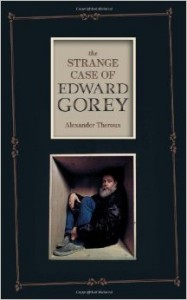Elegant Enigmas: The Art of Edward Gorey
Exhibition at the Boston Athenæum
February 9 – June 4, 2011
 Elegant Enigmas: The Art of Edward Gorey
Elegant Enigmas: The Art of Edward Gorey
by Karen Wilkin
Pomegranate Communications
124 pages, $29.95
 The Strange Case of Edward Gorey
The Strange Case of Edward Gorey
by Alexander Theroux
Fantagraphics Books. 166 pages, $19.95
BEFORE HIS DESIGNS for the Broadway production of Dracula and his animated titles for the television series Mystery! made him internationally famous, Edward Gorey was known mainly for a series of quirky little books of which he was not only the illustrator but the author and sometimes the publisher as well. Some of these, like the abecedarian catalogue of untimely deaths called The Gashlycrumb Tinies, exemplify the archly sinister atmosphere that became Gorey’s trademark. Others are less macabre than impish, and one or two even have something like a happy ending. Almost always, though, they conform to the same pattern: twenty or thirty postcard-sized pictures drawn in black and white, one to a page, each with a few lines of text, which is often rhymed and always lettered by hand.
The original artwork for a few dozen of these illustrations, representative of the hundreds that Gorey drew between The Unstrung Harp (1953) and The Tuning Fork (1990), forms the core of the traveling exhibition mounted by the Brandywine River Museum in Pennsylvania, which is now making its last stop in Boston, at the Athenæum on Beacon Hill. This stately, stolid venue fits quite well with the late-Victorian world that many of Gorey’s characters inhabit, though he was no conventional character himself, a Harvard education notwithstanding. His eccentricity could be flamboyant, and as he declined to conform, so he declined to be labeled. About his sexuality, he maintained that he never said he was gay, but also that he never said he wasn’t, and that before anything else he was a person. Nor would he let himself be categorized either as an author who illustrated his own writing, or the reverse. He never began to illustrate a book before the text was finished, but, on the other hand, some of his books have no text at all—The West Wing, for example, and the drolly menacing Les Passementaries Horribles.
Either way, what is most noticeable about the illustrations themselves is their maniacal detail. Contrary to standard practice, Gorey never made his original drawings larger than they were meant to be on the printed page, where photographic reduction would hide their flaws. They are the same size as the published versions, and consequently their virtuoso technique needs close-range scrutiny, for which the elegant, intimate gallery at the Athenæum is ideal. Visitors can see how each of the contrasting textures, the intricate wallpaper patterns, and the subtle gradations of tone are built up out of thousands of tiny strokes, all made with a single, old-fashioned pen-point. The exhibition provides a glimpse of the artist at work in this painstaking process, in the shape of a drawing that Gorey began for The Blue Aspic (his tragic tale of an opera diva and her besotted admirer) but left unfinished and replaced with a somewhat different version.
Also on display are one Dracula drawing, early designs for book covers, illustrations for poems by Edward Lear and Hilaire Belloc, work sheets, rough drafts of words and pictures, and, in a section of their own, a delightful set of costume designs for The Mikado that combine Japanese and Edwardian couture and—most unusually—make use of colors besides black and white. Apart from a stuffed doll of Gorey’s signature creature Figbash, every item exhibited is also illustrated, usually at full size, in Elegant Enigmas: The Art of Edward Gorey. The illustrations are superb. In many books about Gorey, and even in the Amphigorey anthologies, his crisp, meticulous lines often appear blurred or bloated, or else disappear altogether. Here, with one glaring exception, they are accurately reproduced. On the negative side, it is disappointing to find a humdrum typeface in place of Gorey’s lettering, presumably to save space. An introductory essay by Karen Wilkin, author of perhaps the best Gorey book to date, is nicely poised between bland objective description and fanciful speculation about sources, influences, and hidden meanings. As befits an exhibition catalogue, she concentrates on the art rather than the artist, leaving it to Gorey to describe himself in words quoted from published interviews.
Those interviews, however, which have been collected and republished en masse, tend to be repetitious and superficial. Gorey is cooperative and polite but never seems comfortable with being quizzed. Anyone who craves a more intimate portrait, drawn from life, will find it in Alexander Theroux’s sprawling, chatty book, first published in 2000, the year Gorey died, which has now been revised to coincide with the Brandywine exhibition. Theroux was Gorey’s neighbor on Cape Cod, his friend for thirty years, and his vis-à-vis in seemingly endless conversations about anything and everything. The Strange Case of Edward Gorey is replete with details about its subject’s tastes in literature (The Tale of Genji, Agatha Christie), film (Louis Feuillade, Buster Keaton), and television (soap operas); about his beliefs (skeptically fatalist), his collections (finials, ginger jars, stones, books), his mannerisms (fey, camp, theatrical), his dress (Keds, raccoon coats, handfuls of iron rings), his loves (Oreo cookies, ballet, Bach) and bêtes noires (flattery, fruitcake, Andrew Lloyd Webber), his cats (numerous, neurotic), and his sex life (nil).
Some of the extended comparisons Theroux draws (Auden, Thoreau, Beardsley, Sherlock Holmes) are more perceptive than others, and he is wont to rehearse his own views on, among other things, what is and is not “typically gay”; but such faults are excusable. In Elegant Enigmas, Wilkin ends with the punning observation that Gorey is hors catégorie. In The Strange Case of Edward Gorey, Theroux shows just how apt this observation truly is.
Charles Hefling is a professor at Boston College, where he teaches the Great Books. He also draws caricatures for this journal.






